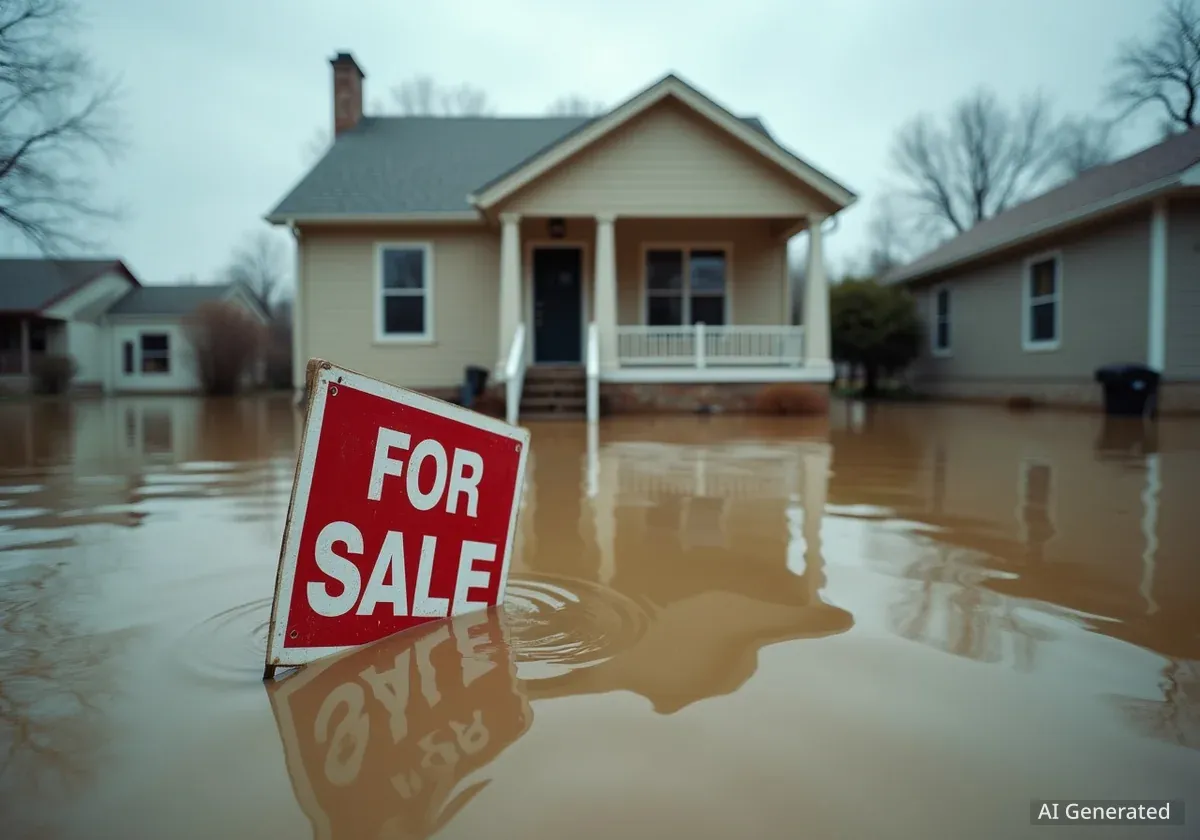A comprehensive analysis of post-flood relocation in the United States reveals a significant trend: the vast majority of homeowners in high-risk areas sell their properties on the open market rather than accepting government buyouts. This practice transfers flood risk to new residents and limits community-wide efforts to adapt to climate change, according to new research from Rice University.
The study, which mapped the movements of over 70,000 residents, highlights the patterns of how communities respond to recurring flood disasters and the role of the Federal Emergency Management Agency (FEMA) buyout program.
Key Takeaways
- A new study shows most movers from flood-prone areas sell their homes privately, not through FEMA's buyout program.
- For every one homeowner who accepts a buyout, approximately 14 neighbors relocate by selling their property, transferring risk to a new owner.
- Despite the risks, most people who move stay local, relocating an average of just 5 to 10 miles away to safer ground.
- Researchers suggest that expanding and improving the federal buyout program is crucial for long-term community flood resilience.
Understanding the Federal Buyout Program
For decades, the U.S. government has offered a solution for homeowners in areas with repetitive, severe flooding. Through FEMA's Hazard Mitigation Grant Program, local governments can apply for funds to purchase high-risk properties from willing sellers.
Once purchased, the homes are demolished, and the land is permanently converted into open space. This strategy prevents future structures from being built on vulnerable land and can help create natural floodplains, parks, or sites for new flood-control infrastructure that protects the surrounding community.
A Proven Investment
FEMA has invested nearly $4 billion to acquire and demolish approximately 45,000 flood-prone homes across the nation, with most of these transactions occurring since 2001. Research indicates the program is highly effective, avoiding an estimated $4 to $6 in future disaster recovery costs for every $1 invested.
How the Program Works
Homeowners who participate in a buyout typically receive the pre-disaster market value for their home. This amount may be reduced by any flood insurance payments they have already received for the same disaster event. The goal is to provide a fair exit strategy for residents while permanently removing the property from risk.
Despite its benefits, the program faces significant challenges. Recent years have seen funding denials and discussions about potential agency cutbacks, placing this tool for community resilience in a precarious position. According to researchers, the focus should be on improving the program, not dismantling it.
New Data Reveals Relocation Trends
To understand what happens after a major flood, a research team at Rice University’s Center for Coastal Futures and Adaptive Resilience developed an interactive mapping tool. Using anonymized, address-level data from 2007 to 2017, they tracked the post-disaster movements of residents in over 550 counties where FEMA buyouts occurred.
The maps provide a detailed view of where people moved after a buyout program was initiated in their neighborhood. It distinguishes between residents who accepted a FEMA-funded buyout and their neighbors who moved on their own.
What is Managed Retreat?
"Managed retreat" is the strategic relocation of people, assets, and infrastructure away from areas vulnerable to natural hazards like flooding and sea-level rise. Government buyout programs are one form of managed retreat, designed to be a planned and voluntary process to reduce long-term risk.
The findings were stark. The data showed that for every household that participated in the federal buyout program, about 14 neighboring households also moved. However, these neighbors relocated by selling or leaving a rental property through conventional means.
"This distinction matters, because it implies that most Americans are retreating from climate-stressed areas by transferring their home’s risk to someone else, not by accepting buyouts that would take the property out of circulation," the researchers explained.
The Hidden Risk of Private Real Estate Sales
While selling a home in a flood-prone area may be a good outcome for the individual seller, it does little to enhance the overall safety of the community. Each private sale introduces a new person or family to the same recurring flood risk, perpetuating a cycle of damage and recovery.
This pattern leaves communities playing what some describe as "climate roulette." New residents may be unaware of the full extent of the flood risk, or they may be willing to accept it for a lower home price. Regardless, the property remains in use, and the community remains vulnerable to future disaster costs.
The 14-to-1 Ratio
The study's finding that non-buyout movers outnumber buyout participants 14 to 1 is a critical statistic. It demonstrates that the private real estate market is currently the primary mechanism for relocation from flood zones, a method that fails to reduce overall community vulnerability.
This cycle may not be sustainable. As storms intensify, flood insurance costs rise, and public awareness of climate risks grows, the market for high-risk homes could shrink. In some coastal communities, signs of a slowdown in sales for flood-prone properties are already emerging, which could limit a homeowner's ability to simply sell and move on.
A Path Forward for Flood Resilience
Despite the challenges, the Rice University study also uncovered positive news. The data shows that when people move from buyout areas, they tend to stay close to their communities. The average relocation distance was only 5 to 10 miles.
This suggests that residents are not abandoning their towns but are instead seeking safer locations nearby, maintaining local social and economic ties. Furthermore, the analysis confirmed that nearly all of these moves were to homes with minimal to minor future flood risk, according to data from the First Street Foundation.
Improving Buyout Programs for the Future
The researchers argue that the U.S. can build safer communities by strengthening and expanding voluntary buyout programs at the federal, state, and local levels. They offer several recommendations for improvement:
- Increase Funding and Accessibility: Ensure that programs are well-funded and that the application process is streamlined for local governments and homeowners.
- Provide More Flexibility: Giving residents a longer period to decide whether to participate could make the program more attractive. This would allow property owners to make a decision on their own timeline while still ensuring the risky property is eventually removed from the market.
- Collective Planning: Use the vacated lands strategically. Communities can plan for how these new open spaces can be used for recreation, habitat restoration, or flood mitigation projects that protect remaining homes.
By making voluntary buyouts a more viable and appealing option, communities can collectively reduce future flood damage and plan for a more sustainable and resilient future, rather than simply passing the risk from one homeowner to the next.





